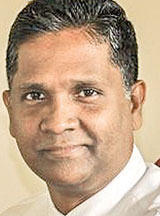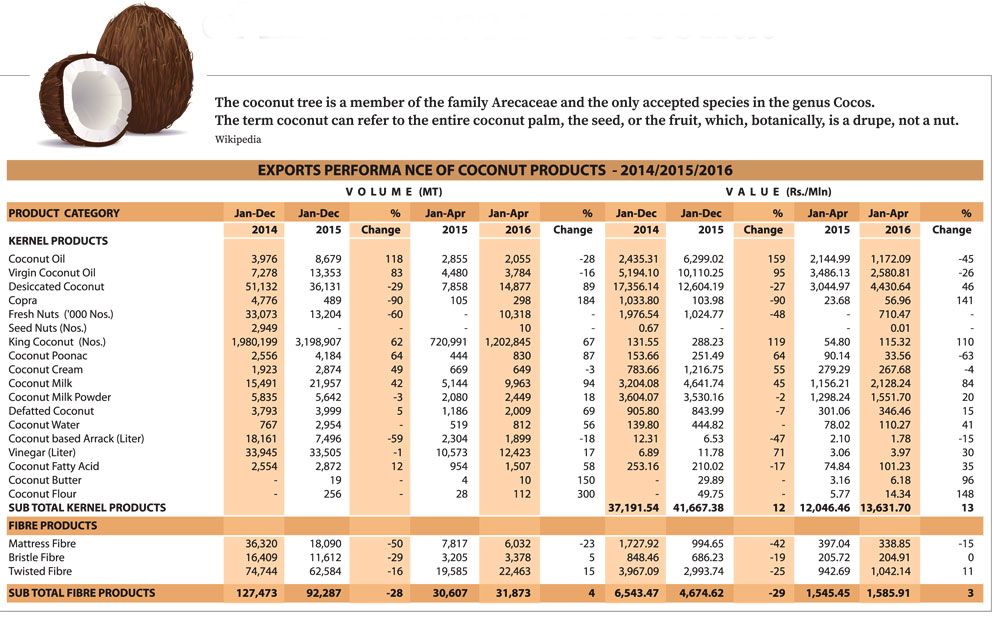Sri Lanka to set up a Centre of Excellence for coconut
Industry needs to focus more on exports:
By Sanjeevi Jayasuriya
Sri Lanka exports only 20% of its total coconut production as 80% is
consumed within the country.
|

Kapila Yakandawala |
"Although it is one of the top five coconut producing countries, our
exports are quite limited and the demand is high in the global market,"
Coconut Cultivation Board, Chairman, Kapila Yakandawala said.
Over 30 percent of Sri Lanka's coconut production is lost by the
wasteful household practises. This has also contributed to the low
export volume, he said in an interview.
Total coconut production for last year was 3,056 million nuts and the
target for this year is 3,600 million.
The five top coconut producing countries in the world are the
Philippines, Indonesia, Malaysia, Sri Lanka and India.
New coconut triangle
"We have identified a new coconut triangle under the North and the
East Coconut project which was launched in March this year. This new
coconut triangle will be spread on 80,000 acres and rehabilitation will
be carried out on 40,000 acres while new planting will be on 40,000
acres," he added.
The 'Tea and Coconut' program was also launched in March to develop
the local coconut industry. This program will be carried out in many
parts of the country except for a few areas in Nuwara Eliya and Badulla
which do not have soil and weather suited for coconut cultivation. The
seeds for this program were introduced by the Coconut Research Institute
and the Rubber Research Institute.
The coconut industry will be developed under various programs and a
Rs. 850 million budget allocation has been made available for the
Kapruka Ayojana loan scheme and for subsidies for this year. This loan
scheme and subsidies are handled by the Coconut Cultivation Board.
There are three organizations for coconut under the Ministry of
Plantation Industries, namely, Coconut Cultivation Board, Coconut
Development Authority and Coconut Research Institute.
Over 1,100,000 acres are under coconut cultivation at present.
"Although there are many varieties of coconut we recommend Tipika,
Morok, CRIC 60, and two other Hybrid types - CRIC 65 and TSR varieties.
The coconuts can be harvested in two seasons per year and the nut market
has the highest demand," the chairman said.
"We cannot meet the global demand for coconut products such as virgin
coconut oil. We have launched a project to increase production in the
new mega coconut triangle as tea and coconut mixed production project.
Measures have also been taken to increase production in existing
plantations through improved seed varieties. We hope to earn US $ 1
billion from coconut and related product exports by 2020," he said.
New products
The Coconut Development Authority has taken measures to identify the
process of value-addition in coconut products through discussion with
industrialists. There are several new products such as coconut paste,
coconut ice cream, spray dried coconut, coconut treacle, pasteurized
coconut milk, coconut skimmed milk and yoghurt base.
There has been continuous research on value-addition and globally
there are 300 value-added products. Sri Lanka produces 54 of those
products; therefore the country has the potential to increase export
earnings through value-addition.
Sri Lanka participated at the Asian Pacific Coconut Community (APCC)
ministerial meeting recently in Jakarta which is the oldest network of
coconut producing countries. It has a membership of 18 countries and 90
percent of world coconut production is represented by the APCC. Coconut
production has seen a declining trend due to global climate changes and
finding ways and means to overcome this problem was discussed. Apart
from climate change there is also the pest and disease issue which has
been given special focus, to increase production.
Health benefits
Coconut being a seasonal crop, price fluctuation in the local and
global market is a drawback to growers. The health benefits of coconut
oil had increased the demand for coconut in the world market.
At the APCC meeting, researchers collected all R&D data with regard
to coconut production and issued a combined statement on nutrition and
health benefits of coconut oil.

The basic discussions were centered on research and on sharing R&D
among member countries. The idea to set up a gene bank was mooted at the
meeting to develop the industry and exchange information among members.
The exchange of data and statistics of international prices, quality
and production was also agreed upon. The APCC will be converted into an
International Growers Community by combining the other 10 percent of the
global coconut producing countries to create an international market
facilitation platform to become a price, quality, trade and marketing
interaction portal.
To further ascertain the nutrition and health benefits of coconut
oil, a working committee was set up with a member from Sri Lanka. In
India, the International Centre of Excellence for coconut was set up to
share R&D work.
A Centre of Excellence for Coconut will be set up this year in Sri
Lanka concurrent to the Indian centre. Sri Lanka has the oldest and one
of the most efficient research centres in the world at Lunuwila in
Bandirippuwa and the new centre to be set up this year is expected to be
of the same standard, he said.
Sri Lanka is the first country to engage in the tissue culture field
as far as the coconut industry is concerned.Though Philippines is the
top coconut producing country, as an industry it is at the primary level
and Sri Lanka is far ahead. Sri Lanka exports the most number of coconut
products including virgin coconut oil, coir products and copra.
"We have a structured plan on every sector of coconut production and
systematic planning to face issues such as pest and disease and will
raise the bar of the coconut industry in Sri Lanka to highlight the
development of the sector. We also possess recorded coconut usage
documents which run back to 2,000 years, which is the oldest in the
world," he concluded.
|

